We grow a rich harvest of Solerosso ultra-early tomatoes and protect it from pests and diseases
We present to your attention the unusual Dutch Solerosso tomato. The early maturity and high yield of the crop were appreciated by many Russian gardeners and are in a hurry to stock up on seed for the next summer season in advance.
There are many lovers of early tomatoes, and early tomatoes with a delicious taste want to try everything. In addition, agricultural technology for the entire growing season is so simple that even a beginner at a summer cottage will get a decent harvest.
The content of the article
Description of culture
The hybrid was launched in Holland in 2006. Judging by the description and reviews, the Solerosso f1 tomato not only successfully took root in the Russian climate, but also managed to win many fans.
Distinctive features
Bush determinant, 0.5-0.6 m high. The branches are moderately spreading, the foliage is medium, the leaves are medium-sized, dark green. The inflorescences are simple, one brush ties up to 6 fruits.
The hybrid is early maturing, from the moment of sowing the seeds to full ripening it takes 90-95 days. Due to its small stature, it is suitable for cultivation on the balcony at home.
The yield is high, from 1 sq. m, up to 8 kg of fruits are harvested, provided that 4-5 seedlings are planted per 1 sq. m.
Recommended for cultivation in the open field and in greenhouse conditions.
The species is highly resistant to the main diseases of the Solanaceae family. Due to the early ripening period, the culture is not affected by late blight.
Plants do not need compulsory pinching, but a garter, despite its small growth, is necessary. The branches, strewn with fruits, cannot withstand the weight and bend to the ground. Fruits may deteriorate due to contact with damp beds.
Fruit characteristics
The average weight of ripe vegetables is 120-140 g, the shape is flat-round, the color is rich red, the pulp is juicy, of moderate density. Seed chambers 6. The peel is thin, but strong, the taste is sweet, without acidity and wateriness.
The purpose of tomatoes is universal: they are eaten fresh, used for pickling, canning and pickling. Ripe vegetables are also used for processing for tomato products.
Tomatoes are subject to long-term storage and long-term transportation. Thanks to the strong peel, they retain an excellent presentation for 40 days, which allows entrepreneurs to use the hybrid for commercial purposes.
The photo shows the Solerosso tomatoes.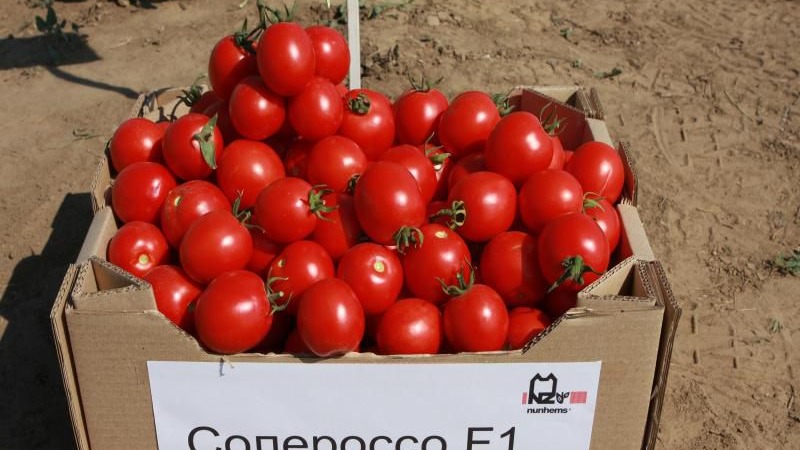
How to grow seedlings
Sowing seeds for seedlings begins 2 months before planting in the ground. In the greenhouse, as a rule, they are transplanted 2 weeks earlier than in open beds. The main thing is to wait until the soil warms up to 15 ° C, otherwise the growth of young bushes will slow down.
Seed preparation
Since the culture is hybrid, it will not be possible to harvest the seeds on your own - the hybrids do not preserve the parental genes in the next generation. Therefore, the seed will have to be bought every time.
The purchased grains do not need processing, the producer took care of everything himself. It is only necessary to assess the external condition of the planting material. To do this, it is laid out on the table and carefully examined for visible defects: the grains should be light, without visible damage.Then check for emptiness by dipping in saline solution for 10 minutes.
Those seeds that floated to the surface are empty inside, which means they are not suitable for planting. The rest are washed with running water and dried.
reference... To prepare a saline solution, 1 teaspoon of salt is diluted in a glass of water.
To improve germination, planting material is treated with a growth stimulator and germinated on wet gauze for 2-3 days at a temperature of 25 ° C until sprouts appear. As it dries, the gauze is moistened with warm water.
Capacity and soil
A nutritious soil mixture is prepared from garden soil, humus, peat and river sand in equal proportions. After thoroughly mixing all the components, a little wood ash is added to the resulting mixture.
reference... Ash enriches the sprouts with calcium and magnesium.
The prepared soil is disinfected to destroy pathogenic flora by spilling it with a hot solution of pink potassium permanganate. Also, the soil is disinfected in an oven for 15 minutes at a temperature of 60 ° C.
After disinfection, the soil is poured into the planting containers by half. Later, as the bushes grow, the remaining soil is poured into containers, thanks to which the plants receive the necessary nutrients.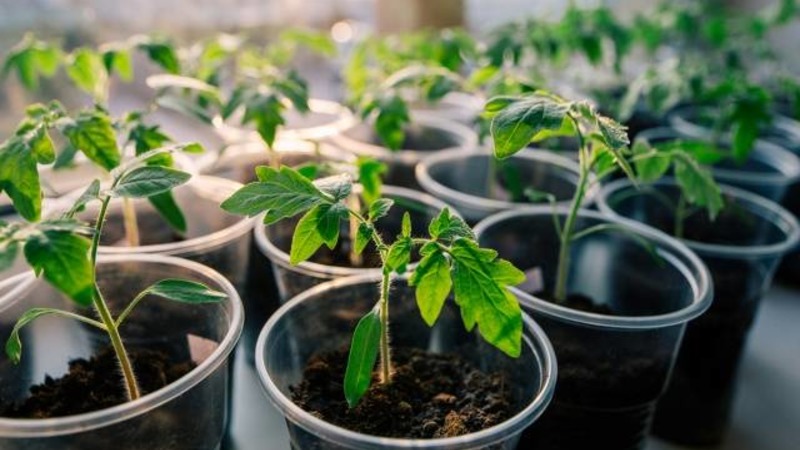
They are planted in a common wooden box or in an individual container, at the bottom of which drainage holes are made so that excess moisture can drain into them. Seedlings in individual containers do not need picking, therefore, sowing in individual containers greatly simplifies the care of seedlings.
Sowing
The seeds are sown to a depth of 1.5 cm with a distance of 2 cm from each other, sprinkled with peat on top, slightly moistened with warm, settled water using a spray bottle and covered with a film to create a greenhouse effect.
Then the containers are left in a warm room at a temperature of 25-26 ° C. At lower temperatures, the seeds will germinate later.
Seedling care
At the first shoots, the containers are rearranged in a well-lit place, on the windowsill, the film is removed. Daylight hours for seedlings should be at least 12 hours. If necessary, supplement with phytolamps.
Seedlings are watered with warm, settled water every week. After the appearance of 5 true leaves, watering is increased up to 2 times a week. After watering, the soil is superficially loosened, which helps the plants receive oxygen in the required amount.
When 2 true leaves appear, the seedlings are dived, seated in separate containers. When picking, weak shoots are not transplanted, since they will not be able to take root in the open field.
2-2.5 weeks before planting in the ground, the seedlings begin to harden, taking them outside for no more than 40 minutes. Gradually, the time spent in the open air is increased to 11-12 hours, while the night temperature is reduced to 14 ° C.
How to grow tomatoes
After 2 months, the seedlings are transplanted into the ground. By this time, 6-7 true leaves grow on each bush, and the height of the stem reaches 25 cm.
Landing
Planting pattern: 40 cm - the distance between the seedlings, 50 cm is left between the rows.
They are planted in shallow holes after sunset or on a cloudy day. After planting, the holes are abundantly watered with warm, settled water and the young bushes are left to adapt in a new place for 1 week.
reference... Tomatoes are not planted in the same place every season. Good predecessors are legumes, cabbage, carrots and winter crops.
Further care of the Solerosso tomato variety
Regular watering is set once a week, maintaining this regime until flowering begins. During the flowering period, the amount of moisture consumed increases. At least 3-5 liters of water are added under each bush.
Water in the morning or evening hours, when there is no direct exposure to sunlight.
reference... The amount of moisture affects the rates of fruiting. Prolonged drought leads to the fall of the ovaries, with an excess of moisture, plant growth slows down.
After each watering, the soil is loosened, spud and weeds are removed with roots. On dry days of the garden mulch peat or straw. This helps the soil stay hydrated for longer. In addition, mulch protects against the penetration of insect pests to the roots of plants.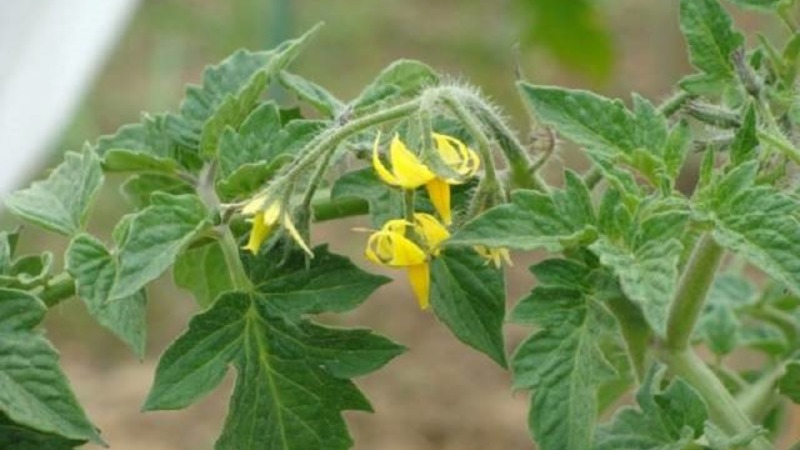
Top dressing for tomato are mineral fertilizers or organic matter. The main trace elements consumed are phosphorus and potassium. Potassium is responsible for taste, and phosphorus regulates metabolic processes required during the growing season.
For potash feeding, 30 g of potassium sulfate is diluted in 10 liters of water. Top dressing is applied at the root after watering. Superphosphate provides the plant with phosphorus. It is diluted in a proportion of 40 g per 10 liters.
They are fed three times during the growing season: during flowering, during the formation of ovaries and during the fruiting period.
During flowering, to stimulate the ovary, a boric acid-based solution (1 g per 10 l) is added to the dressing.
As an organic matter, an infusion of mullein is used in a ratio of 1:10 or wood ash, from which infusions are prepared for irrigation.
Features of cultivation and possible difficulties
The culture does not need pinching, which greatly simplifies care. But a garter, despite the low growth of bushes, cannot be done. The support is installed next to each plant and fixed immediately during transplantation, thereby forming a strong and even stem. Additionally, the support protects young bushes from wind and precipitation.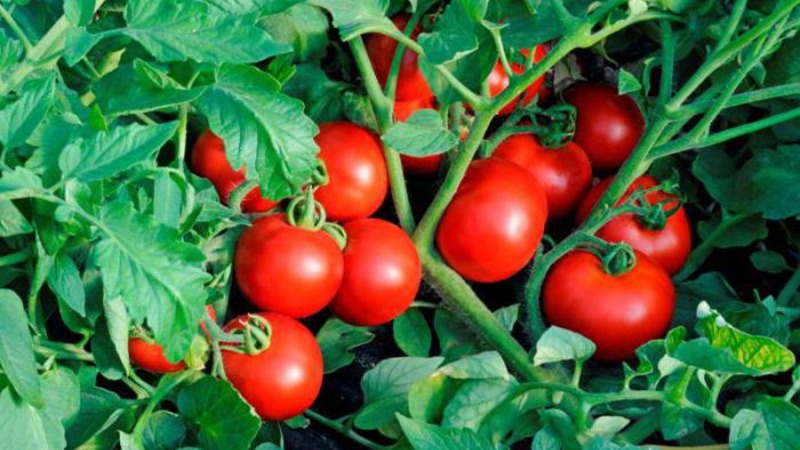
Diseases and pests
The hybrid is immune to many diseases of the nightshade family. Due to the early ripening period, the tomato does not undergo late blight... However, young bushes are susceptible to gray rot. Prevention against this fungal disease is frequent loosening of the soil and moderate watering without moisture stagnation in the beds. In case of defeat, the drug "Fitosporin" or 1% Bordeaux liquid will help to cope with the fungus.
Of the pests for tomato, slugs, bear, aphids and whiteflies are dangerous. Celandine infusion will help to get rid of whitefly and bear. Aphids are afraid of the soapy solution used to treat plant stems, and ammonia diluted in water fights slugs.
The nuances of cultivation in the open field and in the greenhouse
The Dutch culture adapts equally well to greenhouse conditions and to open ground. When planting in closed structures, it is recommended to change the top layer of the earth, since it is on the surface that pest larvae and pathogenic spores winter. Greenhouse soil is subject to mandatory disinfection.
The hybrid loves warmth, so it is most productive in regions with warm and temperate climates.... When breeding it in the middle lane, it is necessary to have a covering material on hand in case of an unexpected cold snap or prolonged rains.
Attention! The greenhouse must be regularly ventilated, since fresh air destroys the spread of fungal spores and the habitual habitat of many greenhouse pests.
The hybrid adapts not only in the greenhouse and in open beds, it is successfully bred on the balcony. The compact size of the bushes and simple agricultural technology allow you to get a decent harvest even at home.
Harvesting and application of the crop
The early ripening period allows you to get ripe tomatoes at the very beginning of summer. Excellent taste vegetables are good not only for fresh consumption, but also for preparation for the winter.
Fresh tomatoes are ideal in summer salads, a variety of snacks, hot dishes and vegetable dishes such as stews or mashed potatoes. Smaller tomatoes are allowed for pickling as a whole. Also, the tomato does not lose its taste in marinades, preserves and processed tomato products - ketchups, juices, lecho, adjika.
Ripe vegetables are subject to long-term storage and can withstand long-term transportation for 40 days without losing their presentation.This favorable factor was immediately seen by entrepreneurs and began to use the Solerosso tomato for commercial purposes.
Advantages and disadvantages
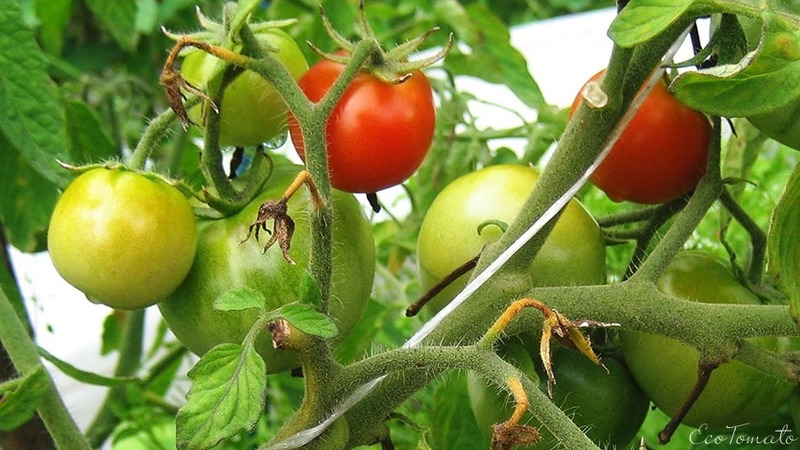
Let's start with the positive characteristics of the hybrid:
- uncomplicated agricultural technology;
- early maturing view;
- high adaptation to any climatic conditions;
- high rate of fruiting;
- immunity to many diseases;
- does not require pinning;
- the possibility of breeding at home;
- excellent fruit taste;
- marketable condition;
- long-term storage;
- long transportation;
- universal application.
The disadvantages of the culture include the need for a garter of low-growing bushes and the purchase of seeds for each planting.
Farmers reviews
There are no unsatisfactory reviews about the hybrid. Gardeners especially note the excellent taste and high quantitative indicator of the culture in all climatic zones.
Valentina, Chernihiv: “I bought hybrid seeds last year. The fruits are well suited for canning. I used them whole, which made it possible to quickly roll up the cans. The bushes bloomed profusely, even the tops were hard to see. She did not stepchild, but tied up, watered and fed. It is a pity that seeds have to be bought every time. It's good that the price is affordable. "
Maria, Rostov-on-Don: “I have been planting the hybrid for the third year. The stem is powerful, with a large number of racemes. Pollination problems never arise, the yield is high. I constantly process the plantings, so I did not observe top rot and other diseases. When feeding and watering, the fruits gain up to 150 g. The taste is excellent. This tomato has become one of my favorites and a permanent inhabitant of my garden. "
Conclusion
The Solerosso tomato variety is excellent for growing both in small gardens and on an industrial scale. Perfectly adapting to any climatic conditions and requiring minimal maintenance, the culture has long interested farmers as a source of income. The long keeping quality of the fruits and the great demand on the market leave no doubt about the choice of tomato.
The hybrid grown in a small summer cottage also pleases gardeners with a high fruiting rate and excellent taste, which are perfectly preserved not only in fresh vegetables, but also in winter preparations.